A gentle celebration of the loving relationship between a toddler and parents, who just happen to be queer.
The story takes us on a journey with the family throughout an adventurous day as they bicycle to a farm and a zoo, then come home for dinner, bath time, story time, and bed. Manushkin, a prolific children’s author whose first book came out in 1972, uses catchy wordings and bouncy rhymes to elevate this over many “day in the life” books. On the farm, for example, “Every worm has a wiggle, and every cow has a moo./ There’s a leap for each frog, and a peek for each BOO!”
It’s the bedtime section that will win readers’ hearts, however, as the family watches stars, fireflies, and animals getting ready for the night, then reads a few stories, woven in with messages of love. Readers of all ages should love winding down for bed along with them.
Illustrator Kip Alizadeh’s images play an equal part in showing the feelings of this family for each other as they smile, play, and hug throughout the book. The love on their faces is obvious.
The publisher says the book is about two moms, which implies (but doesn’t absolutely confirm, of course) that they identify as women—but one parent could be read as nonbinary, clad in jeans and an open shirt over a tank top (and in later scenes, just the tank top), with light skin and short brown hair styled in an undercut; there’s a heart tattoo on one arm. How the parent would actually identify remains unknown, but Alizadeh, who is nonbinary themself, has clearly wanted to show a range of gender expressions.
If the character does identify as a woman, she’s one of few with a more masculine gender expression in children’s books (even LGBTQ-inclusive ones) from major publishers. (One exception is Patricia Polacco’s 2009 In Our Mothers’ House, where both moms have short hair and more masculine or gender-ambiguous clothes.) (If you want to read more about why this kind of representation is important, see this 2020 New York Times piece on butch and stud lesbians.) The other mom has slightly darker skin and long black hair, and wears a t-shirt and skirt. The child, whose gender is never noted, has a skin tone closer to hers.
As a nice background detail, too, we see a picture in the child’s bedroom that shows the family at a Pride celebration. This is a thoughtful detail that gives this depiction of a queer family even more authenticity.
The book isn’t about queerness or gender expression, though, even as it expands the gender expressions usually seen in children’s books. The story would work with parents of any gender. Manushkin told me via online message, though, that “I wanted my book to be very inclusive!” and for that, we should be grateful. The love between parents and child is evident on every page, in both the words and pictures, and that’s the real point. This simple and sweet tale for toddlers and preschoolers has a message that should appeal to families of all types, even as it’s bound to become a particular favorite in many queer households. Add it to your library today.
[Note: Illustrator Kip Alizadeh went by a different first name when the book first came out. I have changed it above and updated the cover image.]






